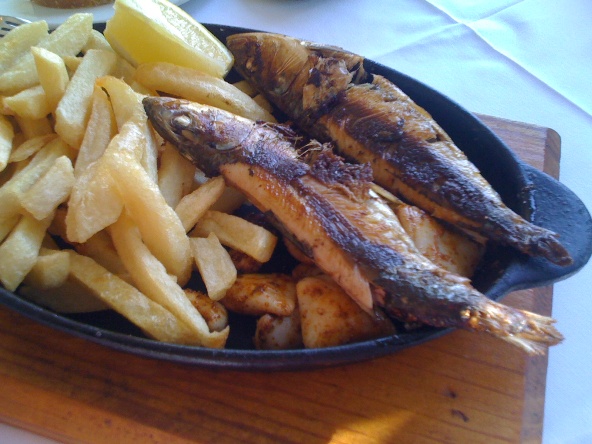This year’s sardine run was much later than usual. In the past 10 years, with one exception, the sardines start to amass off the south coast in June swimming north; on exceptional years, they reach Durban. By mid-July this year, newspaper headlines were crying, ‘Where are the sardines?’ The waves finally turned silver with fish off Umhlanga on July 21. Roadside vendors flogged crates of the little fish for R300 (the price had dropped from R500 at the hesitant start to the run). The bounty continued into the first weeks of August up to Ballito Bay.
The sardine run is an underwater version of the wildebeest migration on the Serengeti and undoes it on a biomass scale. It attracts not only hundreds of whales, thousands of sharks, tens of thousands of dolphins, and a hundred thousand seabirds, but it is also good bait for tourists. There are several festivals centred around Port Edward and Margate beach. The annual feast brings bird- and whale watchers. Spotter planes track the giant shoal, which can be a staggering 7km long, and direct avid scuba divers to where they can see a feeding frenzy of predators, among them the mysterious Bryde’s (after a Norwegian surname pronounced broo-dah’s) whale, bottle-nosed dolphin, copper and hammerhead shark.
Our local sardine (sardinops sagax ocellata) populations rise and fall dramatically, by the billions, due to a host of slenderly understood environmental factors.
Monterey, California, the underclass setting for John Steinbeck’s novel Cannery Row, went from three million cases of cans to next to nothing by the 1950s; the abundant Celtic sardines off Brittany suddenly disappeared in the 1960s. Estimating allowable catches is clearly tricky. Currently, the national annual South African quota is 90 000 tonnes for its hundred-odd license holders.
Most of these little fish, the sexually mature bigger ones called pilchards, are beheaded and canned in brine, tomato sauce or ‘vegetable oil’. Olive oil is best, and some people swear the sardines mature in the can and should be left in a cupboard for three years.
Lucky Star (in the flat, ring-pull can) and Saldanha (in small cylindrical cans) are two popular brands of South African sardines. We also import a lot. John West offers Scottish sild sardines, while their regular sardines are products of Morocco or Portugal. The Cape Point brand is actually from Morocco. King Oscar oak-smoked sardines are packed in Poland. Woolworth’s brisling sardines (called sprats) are also packed in Poland and fished in the North Sea and the fjords of Norway. To my taste, the best of the canned are these tiny brisling with lots of pepper on a buttered, lightly-toasted baguette. But nothing compares to fresh sardines.
Increasingly, restaurants are advertising themselves as ‘sustainable seafood’ establishments, but you can eat sardines in good conscience anywhere, scientists tell us. That is, if you can find them on the menu.
The upmarket Bahia in the V&A Waterfront used to do stunning sardines years ago, but have dropped the dish. Mariner’s Wharf doesn’t bother with sardines anymore either. Your best chance will be at those restaurants that offer a variety of fish for their catch of the day, such as the Cape Town Fish Market.
The day I called around, I found only one place with fresh sardines, The Codfather in Camps Bay. Among the first to offer sushi on a conveyor belt, this casual eatery was unusual in its day for Cape Town. At a deli-style counter, laid out on crushed iced was fresh fish – yellowtail, butterfish, kingklip, kabeljou, sole. You order by weight, as many species as you like. You have to ask if you want to know the price, something that puts many locals off, and has tourists spending far more than they expect.
I ordered a 100g calamari (R36.30) and two glistening sardines (R37.72). The manner of their display made them look like decoration for the other fish. The waiter hid his disappointment well, but it was as if I had ordered the plastic lobster. They still had healthy staring eyes. Sardines go bad quickly; apparently, it’s the downside to their being so rich in omega-3 fatty acids. I’ve had rancid ones in a pricey restaurant that subsequently went bankrupt.
My table at the Codfather, shaded by a loquat tree in bud growing outside, had a glimpse of the sea and the windows opened to the air. Rap music played in the background. Four sauces arrived in glass ramekins: garlic butter, apricot, lemon butter and a lethal chili sauce.
The fish is gutted and cooked whole (as it should be), and served in an oblong, cast-iron skillet. I start by slicing the head open from underneath. The gill filaments tumble out and release a smell of the sea I find appetizing. Some people eat the unpleasantly bitter, black, pulpy meat inside the head.
The backbone is easily removed together with the main skeleton. You don’t have to be too careful about this; most people can eat the bones safely, but always have some fresh bread on hand to help down the occasional stubborn one, though even these are less trouble than a popcorn husk.
Sardines have always been with me, from impecunious student days to my first poem in primary school, which I was required to illustrate, Spike Milligan’s wonderful nonsense verse:
A baby sardine saw her first submarine,
She was scared and watched through a peephole.
“Oh come, come, come”, said the sardine’s mum,
“It’s only a tin full of people!”
The Natal Sharks Board offers a Sardine Run hotline annually (around June to August) on 082 284 9495.
The Codfather, 37 The Drive, Camps Bay. Tel: 021 438 0783.
Published in the Mail & Guardian, August 13, 2010

